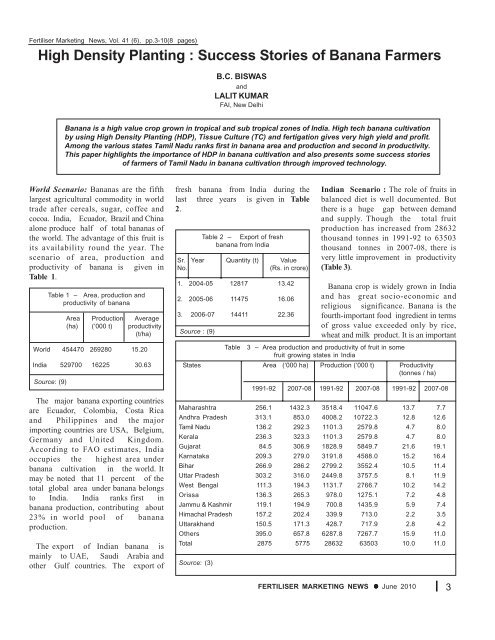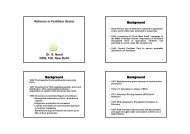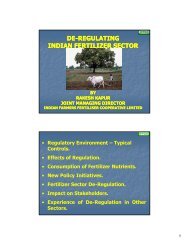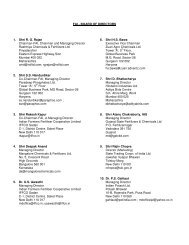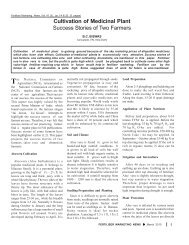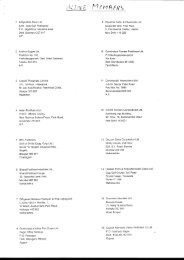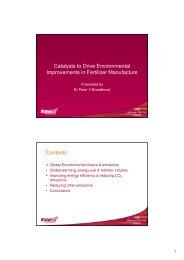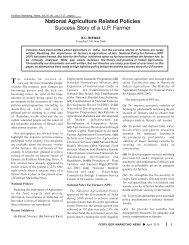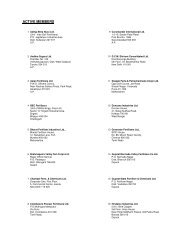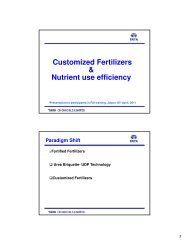High Density Planting : Success Stories of Banana Farmers
High Density Planting : Success Stories of Banana Farmers
High Density Planting : Success Stories of Banana Farmers
- No tags were found...
You also want an ePaper? Increase the reach of your titles
YUMPU automatically turns print PDFs into web optimized ePapers that Google loves.
Fertiliser Marketing News, Vol. 41 (6), pp.3-10(8 pages)<br />
<strong>High</strong> <strong>Density</strong> <strong>Planting</strong> : <strong>Success</strong> <strong>Stories</strong> <strong>of</strong> <strong>Banana</strong> <strong>Farmers</strong><br />
B.C. BISWAS<br />
and<br />
LALIT KUMAR<br />
FAI, New Delhi<br />
<strong>Banana</strong> is a high value crop grown in tropical and sub tropical zones <strong>of</strong> India. <strong>High</strong> tech banana cultivation<br />
by using <strong>High</strong> <strong>Density</strong> <strong>Planting</strong> (HDP), Tissue Culture (TC) and fertigation gives very high yield and pr<strong>of</strong>it.<br />
Among the various states Tamil Nadu ranks first in banana area and production and second in productivity.<br />
This paper highlights the importance <strong>of</strong> HDP in banana cultivation and also presents some success stories<br />
<strong>of</strong> farmers <strong>of</strong> Tamil Nadu in banana cultivation through improved technology.<br />
World Scenario: <strong>Banana</strong>s are the fifth<br />
largest agricultural commodity in world<br />
trade after cereals, sugar, c<strong>of</strong>fee and<br />
cocoa. India, Ecuador, Brazil and China<br />
alone produce half <strong>of</strong> total bananas <strong>of</strong><br />
the world. The advantage <strong>of</strong> this fruit is<br />
its availability round the year. The<br />
scenario <strong>of</strong> area, production and<br />
productivity <strong>of</strong> banana is given in<br />
Table 1.<br />
Table 1 – Area, production and<br />
productivity <strong>of</strong> banana<br />
Area Production Average<br />
(ha) (‘000 t) productivity<br />
(t/ha)<br />
World 454470 269280 15.20<br />
India 529700 16225 30.63<br />
Source: (9)<br />
The major banana exporting countries<br />
are Ecuador, Colombia, Costa Rica<br />
and Philippines and the major<br />
importing countries are USA, Belgium,<br />
Germany and United Kingdom.<br />
According to FAO estimates, India<br />
occupies the highest area under<br />
banana cultivation in the world. It<br />
may be noted that 11 percent <strong>of</strong> the<br />
total global area under banana belongs<br />
to India. India ranks first in<br />
banana production, contributing about<br />
23% in world pool <strong>of</strong> banana<br />
production.<br />
The export <strong>of</strong> Indian banana is<br />
mainly to UAE, Saudi Arabia and<br />
other Gulf countries. The export <strong>of</strong><br />
fresh banana from India during the<br />
last three years is given in Table<br />
2.<br />
Table 2 – Export <strong>of</strong> fresh<br />
banana from India<br />
Sr. Year Quantity (t) Value<br />
No.<br />
(Rs. in crore)<br />
1. 2004-05 12817 13.42<br />
2. 2005-06 11475 16.06<br />
3. 2006-07 14411 22.36<br />
Source : (9)<br />
Indian Scenario : The role <strong>of</strong> fruits in<br />
balanced diet is well documented. But<br />
there is a huge gap between demand<br />
and supply. Though the total fruit<br />
production has increased from 28632<br />
thousand tonnes in 1991-92 to 63503<br />
thousand tonnes in 2007-08, there is<br />
very little improvement in productivity<br />
(Table 3).<br />
<strong>Banana</strong> crop is widely grown in India<br />
and has great socio-economic and<br />
religious significance. <strong>Banana</strong> is the<br />
fourth-important food ingredient in terms<br />
<strong>of</strong> gross value exceeded only by rice,<br />
wheat and milk product. It is an important<br />
Table 3 – Area production and productivity <strong>of</strong> fruit in some<br />
fruit growing states in India<br />
States Area (‘000 ha) Production (‘000 t) Productivity<br />
(tonnes / ha)<br />
1991-92 2007-08 1991-92 2007-08 1991-92 2007-08<br />
Maharashtra 256.1 1432.3 3518.4 11047.6 13.7 7.7<br />
Andhra Pradesh 313.1 853.0 4008.2 10722.3 12.8 12.6<br />
Tamil Nadu 136.2 292.3 1101.3 2579.8 4.7 8.0<br />
Kerala 236.3 323.3 1101.3 2579.8 4.7 8.0<br />
Gujarat 84.5 306.9 1828.9 5849.7 21.6 19.1<br />
Karnataka 209.3 279.0 3191.8 4588.0 15.2 16.4<br />
Bihar 266.9 286.2 2799.2 3552.4 10.5 11.4<br />
Uttar Pradesh 303.2 316.0 2449.8 3757.5 8.1 11.9<br />
West Bengal 111.3 194.3 1131.7 2766.7 10.2 14.2<br />
Orissa 136.3 265.3 978.0 1275.1 7.2 4.8<br />
Jammu & Kashmir 119.1 194.9 700.8 1435.9 5.9 7.4<br />
Himachal Pradesh 157.2 202.4 339.9 713.0 2.2 3.5<br />
Uttarakhand 150.5 171.3 428.7 717.9 2.8 4.2<br />
Others 395.0 657.8 6287.8 7267.7 15.9 11.0<br />
Total 2875 5775 28632 63503 10.0 11.0<br />
Source: (3)<br />
FERTILISER MARKETING NEWS • June 2010 3
Table 4 (a) – Analysis <strong>of</strong> nutrients in<br />
<strong>Banana</strong> fruit (Nutritive value per 100 g)<br />
Principle<br />
Nutrient value<br />
Energy<br />
90 Kcal<br />
Carbohydrates<br />
22.84 g<br />
Protein 1.09g<br />
Total Fat<br />
0.33 g<br />
Cholesterol<br />
0 mg<br />
Dietary Fiber<br />
2.60 g<br />
Vitamins<br />
Folates<br />
20 mcg<br />
Niacin<br />
0.665 mg<br />
Pantothenic acid<br />
0.334 mg<br />
Pyridoxine<br />
0.367 mg<br />
Rib<strong>of</strong>lavin<br />
0.073 mg<br />
Thiamin<br />
0.031 mg<br />
Vitamin A<br />
64 IU<br />
Vitamin C<br />
8.7 mg<br />
Vitamin E<br />
0.10 mg<br />
Vitamin K<br />
0.5 mcg<br />
Electrolytes<br />
Sodium<br />
1 mg<br />
Potassium<br />
358 mg<br />
Minerals<br />
Calcium<br />
5 mg<br />
Copper<br />
0.078 mg<br />
Iron<br />
0.26 mg<br />
Magnesium<br />
27 mg<br />
Manganese<br />
0.270 mg<br />
Phosphorus<br />
22 mg<br />
Selenium<br />
1.0 mcg<br />
Zinc<br />
0.15 mg<br />
Phyto-nutrients<br />
Carotene-á<br />
25mcg<br />
Carotene—ß<br />
26 mcg<br />
Lutein-zeaxanthin<br />
22 mcg<br />
Source : (USDA National Nutrient data<br />
base)<br />
crop for small and marginal farmers. It is<br />
very rich in various food ingredients<br />
as indicated in Table 4(a) and 4(b).<br />
Table 4(b) – Nutrients content <strong>of</strong> the banana (per 100g ripe, edible banana)<br />
S.No. Nutrients Amount Daily recommended intake<br />
per normal adult<br />
1. Water 74% 240ml<br />
2. Carbohydrates 23 % 300 grams<br />
3. Protein 1% 50 grams<br />
4. Fats 0.5% 65 grams<br />
5. Fibre 2.5% 25 grams<br />
6. Carotene 21 micrograms 800 micrograms<br />
7. Vitamin E 0.27mg 15mg<br />
8. Thiamin (B1) 0.04mg 1.5mg<br />
9. Rib<strong>of</strong>lavin (B2) 0.06mg 1.7mg<br />
10. Niacin 0.7mg 20mg<br />
11. Pyridoxine (B6) 0.29mg 1.3-1.7mg depending on age<br />
12. Folic Acid 14 micrograms 400micrograms<br />
13. Pantothenate 0.36mg 10mg<br />
14. Biotin 2.6 micrograms 300micrograms<br />
15. Vitamine C 11mg 75mg women, 90mg for men<br />
16. Sodium 1mg 2400mg<br />
17. Potassium 400mg 3500mg<br />
18. Calcium 6mg 1000mg<br />
19. Magnesium 34mg 400mg<br />
20. Phosphorus 28mg 1000mg<br />
21. Iron 0.3mg 18mgs<br />
22. Copper 0.1g 2.0mgs<br />
23. Zinc 0.2mg 15mg<br />
24. Chloride 79mg 3400mg<br />
25. Manganese 0.4mg 2.0mg<br />
26. Iodine 8 micrograms 150 micrograms<br />
Source : The banana nutrition group (UK); Dickinson, 2000<br />
The major banana growing states<br />
are Tamil Nadu, Maharashtra, Gujarat,<br />
A.P., Karnataka, Bihar, W.B., M.P., Assam<br />
and Kerala. State wise area, production<br />
and productivity is mentioned in Table<br />
5 and Figure 1 depicts the leading<br />
Table 5 – Statewise area, production and productiviy <strong>of</strong> banana<br />
Sl.No. State/UT Area (000’ ha) Production (000’tonnes) Productivity (t/ha)<br />
2005-06 2006-07 2007-08 2005-06 2006-07 2007-08 2005-06 2006-07 2007-08<br />
1. TAMIL NADU 94.6 102.2 114.1 4647.6 5019.4 6116.5 49.1 49.1 53.6<br />
2. MAHARASHTRA 73.2 73.4 80.0 4608.5 4621.9 4962.9 63.0 63.0 62.0<br />
3. GUJARAT 49.2 53.4 57.7 2498.8 2912.6 3157.7 50.8 54.5 54.8<br />
4. AP 65.0 72.4 75.1 1626.1 2173.3 2254.3 25.0 30.0 30.0<br />
5. KTK 56.4 60.8 59.9 1423.8 1558.5 1513.3 25.2 25.6 25.3<br />
6. BIHAR 28.0 29.0 30.5 959.3 1125.1 1329.4 34.2 38.8 43.6<br />
7. WB 27.8 31.7 37.4 544.9 802.1 892.2 19.6 25.3 23.9<br />
8. MP 15.0 14.9 15.2 730.0 773.0 788.2 48.8 52.0 51.9<br />
9. ASSAM 42.0 43.3 44.1 577.7 598.9 610.9 13.8 13.8 13.8<br />
10. KERALA 61.4 59.1 61.5 491.8 463.8 493.9 8.0 7.8 8.0<br />
11. OTHERS 56.8 63.9 71.4 818.5 949.3 1085.4 14.4 14.9 15.2<br />
Total 569.5 604.2 646.9 18927.0 20997.8 23204.8 33.2 34.8 35.9<br />
Source : (5)<br />
4<br />
FERTILISER MARKETING NEWS • June 2010
Production in 000'MT<br />
7000<br />
6000<br />
5000<br />
4000<br />
3000<br />
2000<br />
1000<br />
0<br />
6116.5<br />
4962.9<br />
3157.7<br />
2254.3<br />
1513.3 1329.4<br />
892.2<br />
788.2<br />
610.9<br />
493.9<br />
tropical to semi arid sub tropic up to 2000<br />
MSL. <strong>Banana</strong> grown under sub tropical<br />
conditions are <strong>of</strong> better quality as they<br />
develop better aroma with crisp pulp. At<br />
higher altitude banana cultivation is<br />
restricted to a few varieties like hill<br />
banana. Mean temperature for optimum<br />
growth varies 20-30ºC. Its growth declines<br />
with increase and decrease in temperature<br />
(4). <strong>Banana</strong> can be grown in all kinds <strong>of</strong><br />
soils provided drainage condition is<br />
good. In sandy loam soil, plants grow<br />
faster compared to heavy soils. The<br />
optimum pH is 6.6 to 7.5.<br />
banana growing states.<br />
Leading <strong>Banana</strong> producing states (2007-08)<br />
<strong>Banana</strong> has a universal demand as<br />
food ingredient. It is also used<br />
intensively for religious purpose. This<br />
is why the price <strong>of</strong> banana<br />
increases steeply during festival season.<br />
It has also very high export value (Table<br />
6).<br />
Table 6 – Country-wise export <strong>of</strong> banana<br />
from India during 2008-09<br />
Country Quantity Value<br />
(‘000 tonnes) (Rs. in million)<br />
U.A.E. 10.2 247.6<br />
Saudi Arabia 5.1 108.9<br />
States<br />
Soil and Climate<br />
<strong>Banana</strong> is well suited for humid sub-<br />
Important <strong>Banana</strong> Varieties<br />
There are large numbers <strong>of</strong><br />
banana varieties growing in different<br />
states (Table 7). The major banana<br />
growing season in Maharashtra, Tamil<br />
Nadu and Kerala are mentioned in<br />
Table 8.<br />
Table 7 – Important banana varieties cultivated in different states <strong>of</strong> India<br />
State Varieties grown<br />
Andhra Pradesh Dwarf Cavendish, Robusta, Rasthali, Amritpant, Thellachakrakeli,<br />
Karpoora Poovan, Chakrakeli, Monthan and Yenagu Bontha<br />
Assam<br />
Bihar<br />
Gujarat<br />
Jharkhand<br />
Jahaji (Dwarf Cavendish), Chini Champa, Malbhog, Borjahaji<br />
(Robusta), Honda, Manjahaji, Chinia (Manohar), Kanchkol,<br />
Bhimkol, Jatikol, Digjowa, Kulpait, Bharat Moni<br />
Dwarf Cavendish, Alpon, Chinia , Chini Champa, Malbhig,<br />
Muthia, Kothia , Gauria<br />
Dwarf Cavendish, Lacatan, Harichal (Lokhandi), Gandevi<br />
Selection, Basrai, Robusta, G-9, Harichal, Shrimati<br />
Basrai, Singapuri<br />
Oman 0.9 22.5<br />
Bahrain 1.2 44.6<br />
Qatar 1.3 31.8<br />
Kuwait 1.5 38.4<br />
Nepal 7.8 30.4<br />
Maldives 1.2 13.9<br />
Japan 0.2 3.9<br />
UK 0.1 2.6<br />
Others 0.9 9.9<br />
Total 30.4 554.5<br />
Source: (APEDA)<br />
Karnataka<br />
Kerala<br />
Madhya Pradesh<br />
Maharashtra<br />
Orissa<br />
Tamil Nadu<br />
West Bengal<br />
Source : (4)<br />
Dwarf Cavendish, Robusta, Rasthali, Poovan, Monthan, Elakkibale<br />
Nendran (Plantain), Palayankodan (Poovan), Rasthali, Monthan,<br />
Red <strong>Banana</strong>, Robusta<br />
Basrai<br />
Dwarf Cavendish, Basrai, Robusta, Lal Velchi, Safed Velchi,<br />
Rajeli Nendran, Grand Naine, Shreemanti, Red <strong>Banana</strong><br />
Dwarf Cavendish, Robusta, Champa, Patkapura (Rasthali)<br />
Virupakshi, Robusta, Rad <strong>Banana</strong>, Poovan, Rasthali,<br />
Nendran, Monthan, Karpuravalli, Sakkai, Peyan, Matti<br />
Champa, Mortman, Dwarf Cavendish, Giant Governor,<br />
Kanthali, Singapuri, Lacatan and Monthan<br />
FERTILISER MARKETING NEWS • June 2010<br />
5
Table 8 – Important seasons for planting<br />
followed in different states <strong>of</strong> India<br />
State <strong>Planting</strong> time<br />
Maharashtra<br />
Tamil Nadu<br />
Kerala<br />
Source: (9)<br />
Kharif - June – July<br />
Rabi - October –<br />
November<br />
February – April<br />
November - December<br />
Rain fed-<br />
April-May<br />
Irrigated crop- August-<br />
September<br />
Improved Fruit Production Technology<br />
As there is practically no scope <strong>of</strong><br />
increasing the area under fruit crop, the<br />
only alternative left is to increases the<br />
productivity. Advance technologies like<br />
<strong>High</strong> <strong>Density</strong> <strong>Planting</strong> (HDP) is a handy<br />
tool to improve the fruit productivity. HDP<br />
is defined as the practice to accommodate<br />
4444 to 5555 plants per hectare and the<br />
yield obtained is about 60 tonnes per<br />
hectare. HDP is one <strong>of</strong> the technique to<br />
enhance the productivity per unit area<br />
both in short duration and perennial<br />
horticultural crop. In perennial crop, it is<br />
more useful because it allows efficient use<br />
<strong>of</strong> land and resources, realizing higher<br />
yield and net pr<strong>of</strong>it per unit area, easy<br />
canopy management suited for farm<br />
mechanization and cultural practices,<br />
efficient spray and weed control,<br />
improvement in fruit quality easy and<br />
efficient harvest <strong>of</strong> high quality product<br />
etc. There are five important means to<br />
achieve HDP. These are:<br />
• Use <strong>of</strong> dwarf scion varities<br />
• Adopting dwarfing rootstock and<br />
inter stock<br />
• Efficient training and pruning<br />
• Use <strong>of</strong> plant growth regulators<br />
• Suitable crop management practices<br />
There are many fruit crops where<br />
desired success has been achieved by<br />
using HDP. These crops are apple, peach,<br />
plum, sweet cherry, pear among temperate<br />
fruits while banana, pineapple and papaya<br />
among tropical fruits. In India, HDP<br />
technology has been successfully used in<br />
banana, pineapple, papaya and mango,<br />
guava and citrus where two to three times<br />
increase in yield have been obtained.<br />
In this paper an attempt has been made<br />
to discuss about the HDP developed by<br />
Indian Institute <strong>of</strong> Horticulture Research<br />
(ICAR), Bengaluru and some success<br />
stories <strong>of</strong> banana farmers.<br />
HDP Technology in <strong>Banana</strong><br />
<strong>Banana</strong> is the forth-important food<br />
ingredient in terms <strong>of</strong> gross value next to<br />
rice, wheat and milk product. In India,<br />
banana contributes to nearly 32% <strong>of</strong> the<br />
total fruit produced in the country. The<br />
normal spacing provided in “Robusta and<br />
Dwarf Cavendish” is 2.1 x 2.1 m (2267<br />
plant/ha) with yield <strong>of</strong> 60 tonnes/ ha. Of<br />
late, the emphasis has been on the<br />
increase in the productivity by providing<br />
closer spacing. This can be done under<br />
good management condition where micro<br />
irrigation and drip fertigation could be<br />
conveniently and successfully practiced.<br />
But main limiting factor in banana in HDP<br />
is the sunlight, which effects flowering,<br />
crop duration, maturity and performance<br />
<strong>Planting</strong> material<br />
Cultivar<br />
<strong>Planting</strong> time<br />
<strong>Planting</strong> density<br />
Pit size<br />
Fertilizer dose<br />
<strong>of</strong> the ratoon crop. The detail <strong>of</strong> the<br />
techniques developed by IIHR,<br />
Bengaluru is mentioned in Table 9 and<br />
the economics <strong>of</strong> HDP in banana has<br />
been indicated in Table 10.<br />
Fertiliser Need in HDP<br />
Table 9 – HDP technique in banana<br />
<strong>Banana</strong> requires high amount <strong>of</strong> plant<br />
nutrients applied partly by soil and partly<br />
by added fertiliser nutrients. Estimated<br />
fertiliser requirement is 10kg FYM, 200-<br />
250gm nitrogen, 60-70gm phosphorus,<br />
300gm potash per plant. <strong>Banana</strong> needs 7-<br />
8 kg N, 0.72- 1.5 kg P 2<br />
O 5<br />
and 17- 20 kg K 2<br />
O<br />
per tonne yield. Generally farmers use<br />
more <strong>of</strong> urea and less <strong>of</strong> P 2<br />
O 5<br />
and K 2<br />
O.<br />
Urea is applied in 3-4 split doses. K 2<br />
O is<br />
recommended depending upon the<br />
cultivar. Plantains need higher K than<br />
other group <strong>of</strong> cultivars. Muriate <strong>of</strong><br />
potash is generally used as a source <strong>of</strong><br />
K. But in soils with pH above 7.5,<br />
potassium sulphate is advantageous.<br />
Calcium influences yield through its<br />
interaction with N, P and K. In acidic soils,<br />
use <strong>of</strong> dolomite (Mg 2<br />
CO 3<br />
) and limestone<br />
(CaCO 3<br />
) as soil amendments is common.<br />
In case <strong>of</strong> acute Mg deficiencies, foliar<br />
Sword suckers with well-developed rhizome, conical<br />
in shape and actively growing control buds weighing<br />
600-750 g are ideal.<br />
Robusta/Dwarf Cavendish<br />
All round the year, best yield when planted during<br />
February-March<br />
A plant density <strong>of</strong> 4444/ha (1.5 m x 1.5 m spacing)<br />
2 ft x 2 ft x 2 ft<br />
Soil application: FYM 40 t/ha, 200g N-100 g<br />
P 2<br />
O 5<br />
-200 g K 2<br />
O/plant/cropFertigation:150 g N and 150 g<br />
K 2<br />
O/plant/crop<br />
Irrigation<br />
Irrigate the crop when the cumulative pan evaporation<br />
values reach 45-50 mm under conventional methods<br />
<strong>of</strong> irrigation. Under drip irrigation, replenishment <strong>of</strong><br />
80% <strong>of</strong> evaporation losses is recommended on a<br />
daily basis.<br />
Bunch weight<br />
25-28 kg<br />
Yield<br />
100-120 t/ha<br />
Advantages <strong>of</strong><br />
a) <strong>High</strong>er productivityb) Economy in fertiliser use<br />
fertigation through fertigation c) <strong>High</strong>er fertiliser use<br />
efficiencyd) Advantage <strong>of</strong> using required fertiliser at<br />
any stage <strong>of</strong> crop growth<br />
Source: (6)<br />
6<br />
FERTILISER MARKETING NEWS • June 2010
Table 10 –<br />
Economics <strong>of</strong> high density banana production (Rs. /hectare)<br />
Cost <strong>of</strong> cultivation Plant crop (Rs.) Ratoon crop (Rs.)<br />
I. Preparatory cultivation<br />
Land preparation 1,000.00 —-<br />
Digging <strong>of</strong> pits (4444 pits) (1.5 m x 1.5 m spacing) (Rs.200/100 pits) 8,888.00 —-<br />
Filling the pits and planting suckers (Rs.80/manday) 4,500.00 —-<br />
Cost <strong>of</strong> the suckers (4,600 nos.) Rs.1.50 each 6,900.00 —-<br />
II. Manuring<br />
Cost <strong>of</strong> FYM (40 tonne @ 100/ton) 4,000.00 4,000.00<br />
Urea (1950 kg/crop) Rs.4.78/kg 9,321.00 9,321.00<br />
Single Super Phosphate (2775 kg/crop) Rs.3.24/kg 8,991.00 8,991.00<br />
Muriate <strong>of</strong> Potash (1480 kg/crop) Rs.4.40/kg 6,512.00 6,512.00<br />
Fertilizer application (4 times/crop) 30 mandays @ Rs.80/manday 2,400.00 2,400.00<br />
III. Inter-culture operations<br />
Irrigation, earthing up, weeding, de-suckering and propping 15,000.00 15,000.00<br />
Cost <strong>of</strong> propping material @ Rs.20/pair <strong>of</strong> poles 80,000.00 —-<br />
Irrigation @ 100/irrigation (40 irrigations) 4,000.00 4,000.0<br />
IV. Plant protection 10,000.00 10,000.00<br />
V. Harvesting 30 mandays @ Rs.80 per Manday 2,400.00 2,400.00<br />
Total 1,63,912.00 62,624.00<br />
B. RETURNS<br />
Price <strong>of</strong> 3,500 bunches with 25 kg bunch (main crop) 3,06,250.00 2,10,000.00<br />
and 3,000 bunches <strong>of</strong> 20 kg bunch (ratoon crop) @ Rs.3.50/kg<br />
Value <strong>of</strong> suckers @ Rs.1.50/sucker 10,000.00 20,000.00<br />
Total Returns 3,16,250.00 2,30,000.00<br />
Total Expenditure 1,63,912.00 62,624.00<br />
Net pr<strong>of</strong>it 1,52,338.00 1,67,376.00<br />
Source : (6)<br />
application <strong>of</strong> Mg SO 4<br />
is found to be<br />
effective. Although sulphur deficiency<br />
in soils has been reported in some cases<br />
but it is not a serious problem in case <strong>of</strong><br />
banana. Sulphur uptake is high during<br />
sucker to shooting stage but after<br />
shooting sulphur supply comes from<br />
leaves and pseudostem.<br />
Combined foliar application <strong>of</strong> ZnSo 4<br />
(0.5%), FeSo 4<br />
(0.2%), CuSo 4<br />
(0.2%) and<br />
H 3<br />
Bo 3<br />
(0.1%) applied at 3,5 and 7 months<br />
after planting helps to increase yield<br />
and quality <strong>of</strong> banana. Stateswise<br />
fertiliser recommendation is given in<br />
Table 11.<br />
Growth Regulators<br />
In order to improve the grade <strong>of</strong><br />
bunches 2, 4 D @ 25 ppm (25 mg/l) may<br />
Table 11 – Use <strong>of</strong> fertiliser in <strong>Banana</strong> crop in different states<br />
States Spacing (m) Fertiliser dose<br />
N (gm/tree) P 2<br />
O 5<br />
(gm/tree) K 2<br />
O (gm/tree) FYM (kg/tree)<br />
Andra Pradesh 2x2 200 40 200 -<br />
Bihar 2x2 125 80 225 9<br />
Gujarat 1.8x1.8 180 90 180 10-15<br />
Karnataka 1.8x1.8 540 (kg/ha) 325 (kg/ha) 675 (kg/ha) 40 (t/ha)<br />
Kerala 1730-2310 plant/ha 160 160 320 10<br />
M.P. 3x1.5-2 230 160 300 20<br />
Maharashtra 1.5x2.5 600 720 600 100 (carts/ha)<br />
Tamil Nadu 1.8x1.8 110 35 330 10<br />
West Bengal 3x3 140 50 120 20<br />
Assam 1.8x2.4 110 35 330 12<br />
Source : (9)<br />
FERTILISER MARKETING NEWS • June 2010<br />
7
e sprayed after the last hand has opened.<br />
This also helps to remove the seeds in<br />
certain varieties e.g. Poovan and CO-1.<br />
Spraying with CCC (1000 ppm.) at 4 th , 6 th<br />
month after planting and plantozyme @ 2<br />
ml/l at 6 th and 8 th month after planting<br />
helps to achieve higher yield.<br />
After full development <strong>of</strong> bunch,<br />
potassium dihydrogen phosphate (0.5%)<br />
and urea (1%) or 2, 4 D solution (10 ppm.)<br />
is to be sprayed on the bunch so that<br />
banana size and quality is improved.<br />
Fertigation<br />
In order to avoid loss <strong>of</strong> nutrients from<br />
conventional fertilisers i.e. loss <strong>of</strong> N<br />
through leaching, volatilization,<br />
evaporation and loss <strong>of</strong> P and K by<br />
fixation in the soil, application <strong>of</strong> water<br />
soluble or liquid fertilisers through drip<br />
irrigation (fertigation) is adopted. A 25-<br />
30% increases in yield is observed using<br />
fertigation. Moreover, it saves labour and<br />
time and the distribution <strong>of</strong> nutrients is<br />
uniform. It may be mentioned here that<br />
every thing is not good with fertigation.<br />
Fertigation creates condition conducive<br />
for disease infestation (7). Rat can also<br />
create serious problem for drip fertigation.<br />
Subsidies in (about 50%) drip irrigation<br />
are the main reason <strong>of</strong> expansion in<br />
fertigation. It is therefore, difficult to say<br />
what would be the fate <strong>of</strong> fertigation if<br />
subsidy is withdrawn.<br />
SUCCESS STORIES OF<br />
BANANA FARMERS<br />
Story 1<br />
Tamil Nadu ranks first in area and<br />
production <strong>of</strong> banana but in Tamil Nadu<br />
banana cultivation has a limitation<br />
because the state experiences strong<br />
winds that cause the falling down <strong>of</strong><br />
banana plant during strong wind. Heavy<br />
rainfall or monsoon failures and absence<br />
<strong>of</strong> proper marketing are some <strong>of</strong> the<br />
limiting factors which have prevented the<br />
farmer not to go in for banana cultivation.<br />
But the farmers <strong>of</strong> Theni, Chinnamanur<br />
and Uthampalayam regions <strong>of</strong> Tamil Nadu<br />
have a different story to mention (Figure<br />
2 and 3). They grow this crop in a<br />
minimum <strong>of</strong> one hectare and are fully<br />
satisfied with the pr<strong>of</strong>it they make.<br />
These farmers normally grow tissue<br />
culture (TC) Grand Naine (GN) banana<br />
variety. GN is a very popular variety<br />
because it has relatively good keeping<br />
quality and also an attractive golden<br />
yellow colour at maturity (9). It is<br />
domestically and internationally liked<br />
both as a fresh fruit and processed form.<br />
The technique generally followed are<br />
mentioned :<br />
1. The field is ploughed well and furrows<br />
are formed 6 feet apart.<br />
2. The planting is done at a distance <strong>of</strong><br />
5-6 feet apart in each furrow.<br />
Figure 2 – Smiling farmer with<br />
his bumper banana crop<br />
3. <strong>Planting</strong> is done at a depth <strong>of</strong> 6 inches<br />
in the furrow.<br />
4. The required quantities <strong>of</strong> organic<br />
manure, 5gm phorate and 200gm neem<br />
cake are applied in each pit.<br />
5. Watering is done thereafter through<br />
drip irrigation.<br />
6. Fertigation starts from 10 th day onwards.<br />
7. Earthing up is done twice.<br />
Management <strong>of</strong> Ratoon Crop<br />
Weed is a serious problem,therefore<br />
necessary inter culture operation is done<br />
to get rid <strong>of</strong> weed infestation. Proper<br />
ratoon management is very important for<br />
higher income and net pr<strong>of</strong>it. In Theni<br />
area normally 3 ratoons in about 25<br />
months are obtained. Once the flower<br />
emerges and all fruits are fully opened, the<br />
bunches are covered by bags which<br />
prevent the tender fruits from insect and<br />
pest attack and helps in maintenance <strong>of</strong><br />
uniform temperature. This operation is<br />
very important for the development <strong>of</strong><br />
colour and fruit. It may be mentioned here<br />
that the farmers in this area have<br />
standarised the harvesting and packing<br />
techniques. <strong>Banana</strong> has a ready market in<br />
Figure 3 – Map <strong>of</strong> banana growing<br />
zone in Tamil Nadu<br />
Source: (9)<br />
8<br />
FERTILISER MARKETING NEWS • June 2010
ig cities like Coimbatore, Madurai, Kochi<br />
and Chennai. The price that the farmers<br />
generally get is quite high (Rs. 10-11/kg).<br />
<strong>Farmers</strong> also send their produce to<br />
distanced city like Kolkata and Mumbai.<br />
The farmers who are interested to grow<br />
banana by using this system are advised<br />
to visit the Theni, Chinnamanur and<br />
Uthampalayam area <strong>of</strong> Tamil Nadu to<br />
gather first hand information.<br />
The data indicated in Table 12 revealed<br />
the interesting fact that a banana farmer<br />
through the adoption <strong>of</strong> improved<br />
technique like HDP could get high yield<br />
and net pr<strong>of</strong>it <strong>of</strong> Rs.4.5 lakhs in about 30<br />
months. This implies that a yearly income<br />
<strong>of</strong> Rs 1.8 lakhs could be obtained from<br />
improved method <strong>of</strong> banana cultivation.<br />
Story 2<br />
Table 12 –<br />
Economics <strong>of</strong> banana cultivation by the farmers (Rs/ha)<br />
Initial investment (Rs) Yield (tonnes) Value (Rs) Net pr<strong>of</strong>it<br />
2,00000 100 4,00000 2,00000.00<br />
Pr<strong>of</strong>it from two ratoons 2,50000.00<br />
Grand total 4,50000.00<br />
Source : (9)<br />
1. Land preparation<br />
2. Application <strong>of</strong> 2 kg <strong>of</strong> single super<br />
phosphate, 200gm <strong>of</strong> gypsum, 20gm <strong>of</strong><br />
furidon and 5 kg <strong>of</strong> FYM.<br />
3. Raised beds <strong>of</strong> about 1 ft in height<br />
were prepared.<br />
4. Cubical pits <strong>of</strong> about 2 cubic feet were<br />
duck on the raised bed.<br />
5. The suckers were planted inside the<br />
pit and covered with soil and then water.<br />
6. Fertigation were done once in five<br />
days.<br />
7. Plant population was 3,000.<br />
8. After two months <strong>of</strong> planting side<br />
suckers were removed.<br />
9. Only one sucker was allowed to grow.<br />
10. In the 7th month stakes were tied to<br />
the trees to prevent them from falling due<br />
to wind or rains.<br />
11. The bunching <strong>of</strong> fruits appeared<br />
during 8th month after planting. During<br />
this time spray <strong>of</strong> poly feed over the fruit<br />
bunches was beneficial.<br />
Economics<br />
Irrigation water and fertiliser are the two<br />
key inputs in crop production. The use<br />
efficiency <strong>of</strong> these inputs through<br />
traditional method <strong>of</strong> application is low.<br />
However modern technique like HDP<br />
coupled with fertigation can result in very<br />
high pr<strong>of</strong>it in case <strong>of</strong> fruit crop like<br />
banana. A banana farmer called Mr. M<br />
Venkatesan (Figure 4), <strong>of</strong><br />
Poduthampatti post, Kuddampatti<br />
village, Somanahalli, Palacode Taluka,<br />
Dharmapuri district <strong>of</strong> Tamil Nadu has<br />
adopted hi-tech agriculture with the help<br />
<strong>of</strong> Tamil Nadu Agriculture University<br />
(TNAU) under the project called<br />
precision farming being operated in<br />
Krishnagiri and Dhramapuri districts with<br />
a project cost <strong>of</strong> Rs.10 crore covering an<br />
area <strong>of</strong> 400 ha in these two districts (8).<br />
These project has become a blessing to<br />
all farmers <strong>of</strong> these districts who have<br />
Figure 4 – Mr. Venkatesan, banana<br />
farmer <strong>of</strong> Dharmapuri having a look at<br />
his crop, which is ready for harvest<br />
been cultivating high value crops like<br />
tomato, lady finger and cavendish variety<br />
<strong>of</strong> banana.<br />
Benefit Accrued<br />
Mr. M Venkatesan one <strong>of</strong> the farmers <strong>of</strong><br />
the project area had cultivated G-9<br />
cavendish variety in one hectare area.<br />
About 25 hectares being cultivated under<br />
banana crop in the Dhramapuri district.<br />
By adopting this technology Mr.<br />
Venkatesan saved 50% <strong>of</strong> irrigation water<br />
(9). The important features <strong>of</strong> the<br />
technology adopted by him are detailed<br />
below.<br />
1. The yield obtained was 100 tonnes (11<br />
month crop).<br />
2. Price per tonne was Rs.8,000/-<br />
3. Income generated Rs.8,000 x 100 =<br />
Rs.8,00000/-<br />
4. Cost <strong>of</strong> drip irrigation was Rs.1.15 lakh.<br />
5. Cost <strong>of</strong> per sucker was Rs.11 So 3,000x<br />
11 = Rs 33,000/-<br />
Emerging New Areas <strong>of</strong> <strong>Banana</strong><br />
Cultivation<br />
Punjab is world famous for the<br />
production <strong>of</strong> cereals particularly through<br />
rice and wheat cropping system. Efforts<br />
have been on for more than three decades<br />
to break the rice-wheat cropping system,<br />
but no visible results were recorded thus<br />
far. Of late, inclusion <strong>of</strong> banana in Punjab<br />
FERTILISER MARKETING NEWS • June 2010<br />
9
is being thought to break these barriers.<br />
Interesting information in this connection<br />
has been published in Indian Express<br />
Finance Chandigarh Edition (dated26/<br />
4/2010) which is reproduced below (1).<br />
To break the wheat and rice rotation<br />
cropping pattern, farmers in Punjab, the<br />
country’s largest foodgrain growing<br />
state are increasingly taking up banana<br />
farming in a big way. <strong>Banana</strong> farming,<br />
which started in Punjab in 2006,<br />
has now emerged as an alternate form <strong>of</strong><br />
farming with its acreage rising from<br />
just 10 acres to 500 acres in four years.<br />
G. S. Kalkat, Chairman <strong>of</strong> Punjab State<br />
<strong>Farmers</strong> Commission said, “<strong>Planting</strong><br />
banana on one acre gives as assured<br />
return <strong>of</strong> Rs1.5 lakh to Rs2.00 lakh.”<br />
He said the Punjab government is<br />
planning to set up banana ripening<br />
chambers in Ludhiana, Patiala and<br />
Jalandhar to help growers. To make the<br />
diversification more attractive, he said,<br />
the state gives farmers a one-time capital<br />
assistance <strong>of</strong> Rs 40, 000 to build a<br />
greenhouse.<br />
Mewa Singh, President <strong>of</strong> <strong>Banana</strong><br />
Growers Association said “going by<br />
present day high price that bananas<br />
fetch in the market, a farmer can make<br />
over Rs 2 lakh from every acre under<br />
banana”. He disclosed that domestic<br />
consumption was also very high as<br />
Punjab consumes bananas worth Rs 600<br />
crore every year, which were hitherto<br />
imported from Maharashtra and Gujarat.<br />
With Punjab going whole hog to grow<br />
bananas like it did for kinnows (a<br />
variety <strong>of</strong> orange), the state can meet at<br />
least half <strong>of</strong> its domestic demand from<br />
own crop.<br />
Singh claims that the quality <strong>of</strong><br />
bananas produced in Punjab is very<br />
good as the state uses a different<br />
technique due to different weather<br />
conditions in this part <strong>of</strong> the country.<br />
The plant is sown in February so as to<br />
keep it safe from fog and frost, which<br />
helps its ripening. <strong>Banana</strong> is most<br />
suited for cultivation in states with<br />
average temperatures <strong>of</strong> 15 -35 ºC and<br />
a rainfall <strong>of</strong> 500-2,000mm every year.<br />
However, Punjab is known for its<br />
extreme temperature, zero degree during<br />
winters and as high 48 degree in<br />
summers. The Punjab State <strong>Farmers</strong><br />
Commission provides special technique<br />
to the farmers to cultivate bananas in<br />
such extreme temperatures.<br />
The fruit has been included in the<br />
National Horticulture Mission and<br />
attracts a 50% subsidy for its plants<br />
and drip irrigation. According to the<br />
Punjab State Farmer Commission, it has<br />
sold 196,000 tissue culture plants this<br />
season.<br />
Sunil Jakhar, MLA from Abohar and<br />
son <strong>of</strong> former Lok Sabha Speaker<br />
Balram Jakhar, observes that “banana’s<br />
inclusion in the National Horticulture<br />
Mission recently is likely to further<br />
encourage Punjab farmers to grow<br />
bananas as up to 50% subsidy will now<br />
be <strong>of</strong>fered for its plants and drip<br />
irrigation”.<br />
FUTURE LINE OF WORK<br />
1. As there exists the scope <strong>of</strong> expansion<br />
<strong>of</strong> banana cultivation even in non<br />
traditional state likes Punjab, the<br />
efforts in this respect need urgent<br />
attention.<br />
2. It is reported that fibre can be<br />
extracted from banana plants and a handy<br />
machine has been designed and<br />
manufactured by KVK, Rajamundry, CTRI<br />
(ICAR), A. P. Promotion <strong>of</strong> this<br />
technology would enhance income at farm<br />
level.<br />
3. <strong>Banana</strong> consumes high amount <strong>of</strong><br />
plant nutrients. Expansion <strong>of</strong> banana<br />
plantation would result in highs fertiliser<br />
use.<br />
4. There exists great scope <strong>of</strong> export <strong>of</strong><br />
value added banana products which<br />
needs urgent attention.<br />
CONCLUSION<br />
HIGH TECH BANANA CULTIVATION CAN<br />
results in very high yield and pr<strong>of</strong>it.<br />
<strong>Banana</strong> price normally dose not<br />
fluctuate so much. Rather its price<br />
goes up during the festivals. Special type<br />
banana can used as vegetable which has<br />
also medicinal value. Processed banana<br />
has both national and international<br />
demand. <strong>Banana</strong> leaves, trunk,<br />
inflorescence i.e. every part <strong>of</strong> it has a<br />
special utility. Plants are used for<br />
religious purposes as well. Cultivation <strong>of</strong><br />
such wonderful crop plants needs due<br />
attention and encouragement which<br />
would result in higher fertiliser<br />
consumption and creation <strong>of</strong> wealth at<br />
farm level.<br />
REFERENCES<br />
1. Ahuja, C., Indian Express Finance dated<br />
April 26, 2010.<br />
2. Annual Report 2007-08, Dept <strong>of</strong><br />
Agriculture & cooperation, MAO, GOI,<br />
New Delhi (2009).<br />
3. Biswas, B. C., Fert. Mktg. News, 41(2)<br />
15 – 18 (2010).<br />
4. Hand Book on Horticulture, Edited by<br />
Chadha, K. L. and Published by<br />
Directorate <strong>of</strong> Information and<br />
Publications <strong>of</strong> Agriculture, ICAR, Krishi<br />
Anusandhan Bhavan, Pusa, New Delhi –<br />
110012 (2002).<br />
5. Indian Horticulture Database 2008<br />
Edited by Kumar et al Published by<br />
National Horticulture Board, MOA, GOI,<br />
85, Institutional Area, Sector – 18,<br />
Gurgaon – 122015 (2008).<br />
6. HDP technologies developed by Indian<br />
Institute <strong>of</strong> Horticulture Research (IIHR),<br />
Bengaluru, Karnataka.<br />
7. Khan, A. and Nazir, Ahmed, Ex.<br />
Pr<strong>of</strong>essor, Plant Pathology, Univ. <strong>of</strong> Agril.<br />
Sciences, Personal communication.<br />
8. Precision Farming Project <strong>of</strong> Tamil Nadu<br />
Agricultural University (TNAU),<br />
Coimbatore, Tamil Nadu.<br />
9. Various websites on Horticulture.<br />
<br />
10<br />
FERTILISER MARKETING NEWS • June 2010


